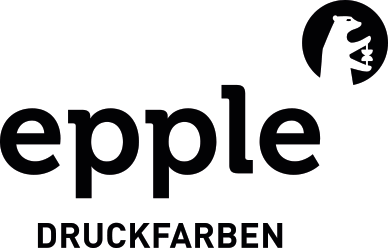STANDARDS
Standard test methods
Standard test methods from Epple Druckfarben AG
Set up of printing test:
The establishment of the proofs is carried out according to DIN ISO 2846-1 and ISO 2834 on a print test device from Prüfbau. In detail, the following parameters underlay the test:
- The proof device is tempered to 30°C.
- Printing speed: 1 m s-1
- Print 600 N cm-1
- Shore-A-Hardness of print form: 60-70° Shore
The duration for oscillating and inking up the printing ink is 20 seconds in each case. After the printing ink has been oscillated in the printing unit, repeated inking up of the print form and the subsequent creation of a proof leads to a series of test prints with varying ink application levels.
1. Coarseness/Fineness
The Norm DIN 53203 (Evaluation of granularity using Grindometer) is the basis for measuring coarseness/fineness. The test is smoothed out with a scraper in a groove with a depth which steadily decreases from 25μm to 0 μm (Grindometer acc. to Hegmann). The scale provides the relevant value under which a larger amount of pigment grains become visible through specks or scratches on the surface of the printing ink level.
Threshold ≤ 5μm
2. Tackiness
The tackiness of 1 ml of printing ink is determined under observation of ISO 12634 with an Inkomat manufactured by Prüfbau at a temperature of 30°C after an inking up time of 60 seconds and a measuring time of 3 minutes and a speed of 100 m min-1.
3. Transparency
The black overprinted part of the sample print strips serve to determine the transparency, which according to DIN ISO 2846-1 exhibits a brightness level under L*= 6. The underlying thickness range is determined in Para. 5.3 in DIN ISO 2846-1. The targeted values are determined in ISO-Norm 2846-1.
4. Densitometry and Colourimetry
The spectrophotometric evaluation of test prints is carried out with a X-Rite SpectroEye (previously GretagMacbeth) with a 45°/0°- Optic acc. to DIN 5033 with directional tendency through ring optics and without Polarisation filters. The details on the measurements and the subsequent calculation of the colourimetric dimensions conform to the guidelines of DIN ISO 2846-1 / DIN ISO 13655; acc. to ISO 12647-2 work is carried out on a black base. The calculation of the standard value is based on the CIELichtart D50 and the CIE Norm Valent system 1931 (2°-standard observer). This method conforms with the guidelines for the process of standard offset printing outlined in the version of May 2003, published by bvdm.
5. Abrasion test
The test prints are rubbed on a Prüfbau Quadrant with 100 strokes and a layer weight of 600g. Production paper is used as counter paper. The abrasion on the counter paper is compared visually with the Epple Scheuerkeil and evaluated.
6. Absorbtion test
The absorption test is carried out on a Prüfbau testing device. An ink application of 1.5g/m² is printed. Subsequently the freshly printed test strip is provided with a counter strip. This will be pressed with a nip roller under pre-determined pressure against the freshly printed strip. At intervals of 30s the test strip will be pushed on. This process will be continued until the end of the test strip has been reached. After the absorption test has been completed, the speed of absorption may be determined from the counter strip on hand of the ink application.
7. Fastness properties
The fastness properties of printing inks for various agents like e.g. Sprit, Nitro und Alkali fastness are tested acc. to ISO 2836 (prev. DIN 16524-25).
8. Lye fastness
Lye fastness especially for reusable bonding labels is tested acc. to DIN 16524-7 with sodium hydroxide.
9. Light fastness
Light fastness is tested acc. to ISO 2835:1974 by means of Xenon test.

